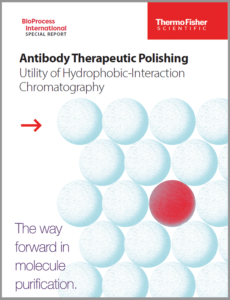Antibody Therapeutic Polishing: Utility of Hydrophobic-Interaction ChromatographyAntibody Therapeutic Polishing: Utility of Hydrophobic-Interaction Chromatography
Sponsored by Thermo Fisher Scientific
 The ultimate goal of downstream purification is to reliably and predictably produce a safe drug product suitable for therapeutic use in humans. To this end, biomanufacturing process- and product-related impurities such as host cell proteins (HCPs), residual DNA, leached protein A, process leachables and extractables, adventitious and endogenous viruses, endotoxins, antibody aggregates, and other antibody variants all must be removed to acceptable levels in conformance with regulatory guidelines.
The ultimate goal of downstream purification is to reliably and predictably produce a safe drug product suitable for therapeutic use in humans. To this end, biomanufacturing process- and product-related impurities such as host cell proteins (HCPs), residual DNA, leached protein A, process leachables and extractables, adventitious and endogenous viruses, endotoxins, antibody aggregates, and other antibody variants all must be removed to acceptable levels in conformance with regulatory guidelines.
Downstream processing of traditional therapeutic monoclonal antibodies (MAbs) has become relatively standardized with an affinity capture step followed by various polishing steps as needed. For novel engineered therapeutic antibody formats, the standardized platform may be suboptimal, and process development scientists can use various chromatographic tools to improve recovery and purity in both the affinity and polishing steps. Depending on a specific residual impurity profile and process challenges, an anion-exchange (AEX) step can be preceded or followed by a second polish step, typically using either cation-exchange (CEX) or hydrophobic-interaction chromatography (HIC). A powerful cost-saving step in any DS process is minimizing buffer exchange and using flowthrough mode in polishing chromatography steps.
This eBook describes a family of POROS HIC resins with novel ethyl and benzyl chemistries for the successful polish of two challenging MAb drug products, both with high levels of aggregates (>10%). In addition to aggregate clearance, viral clearance strategies for these model MAb processes are discussed extensively, including a predictive technique that uses parvovirus surrogate mock virus particles (MVPs) from MockV Solutions as well as live viral clearance data using xenotropic murine leukemia virus (XmuLV) and minute virus of mice (MVM).
The authors show how optimizing important process parameters can improve process efficiency and productivity. They demonstrate how POROS HIC resins can be used as a powerful tool to simplify MAb purification schemes and improve process throughput.
Fill out the form below to read the full report now.
You May Also Like






